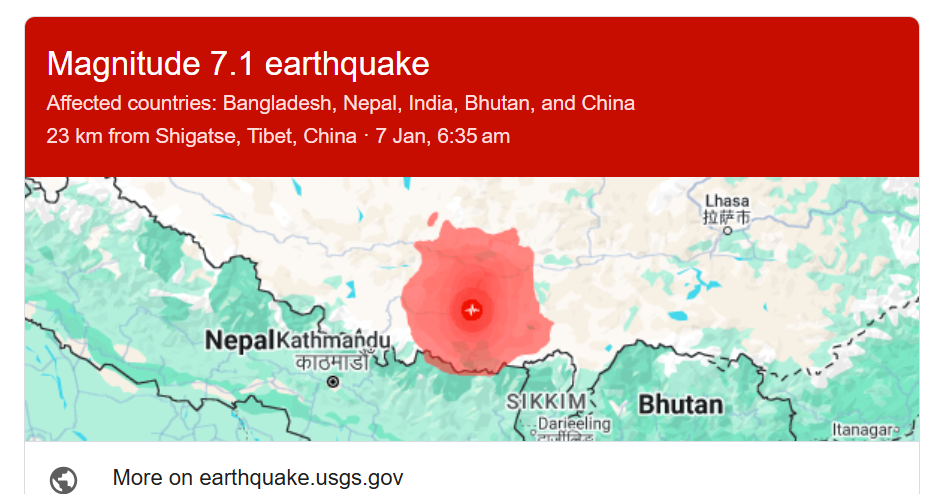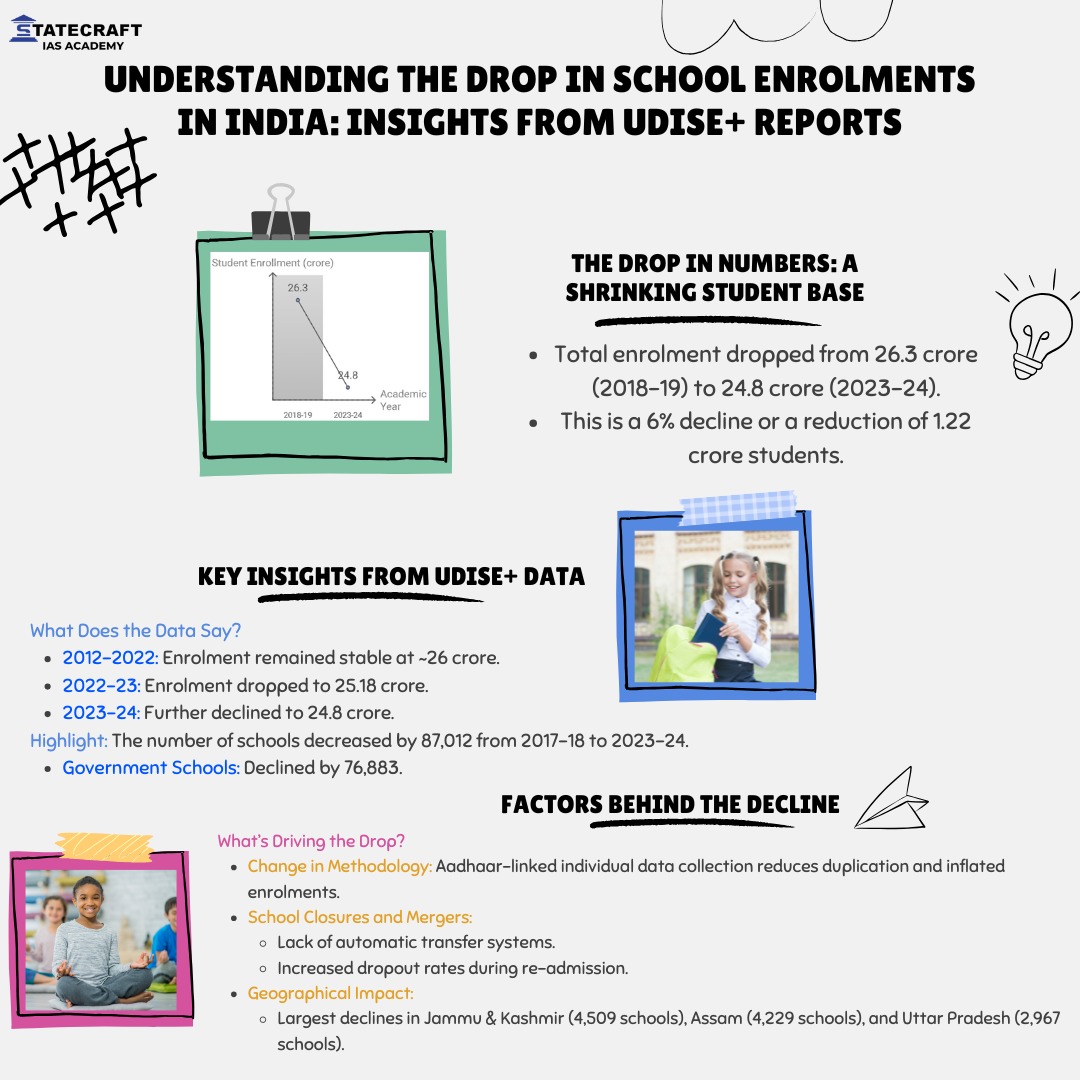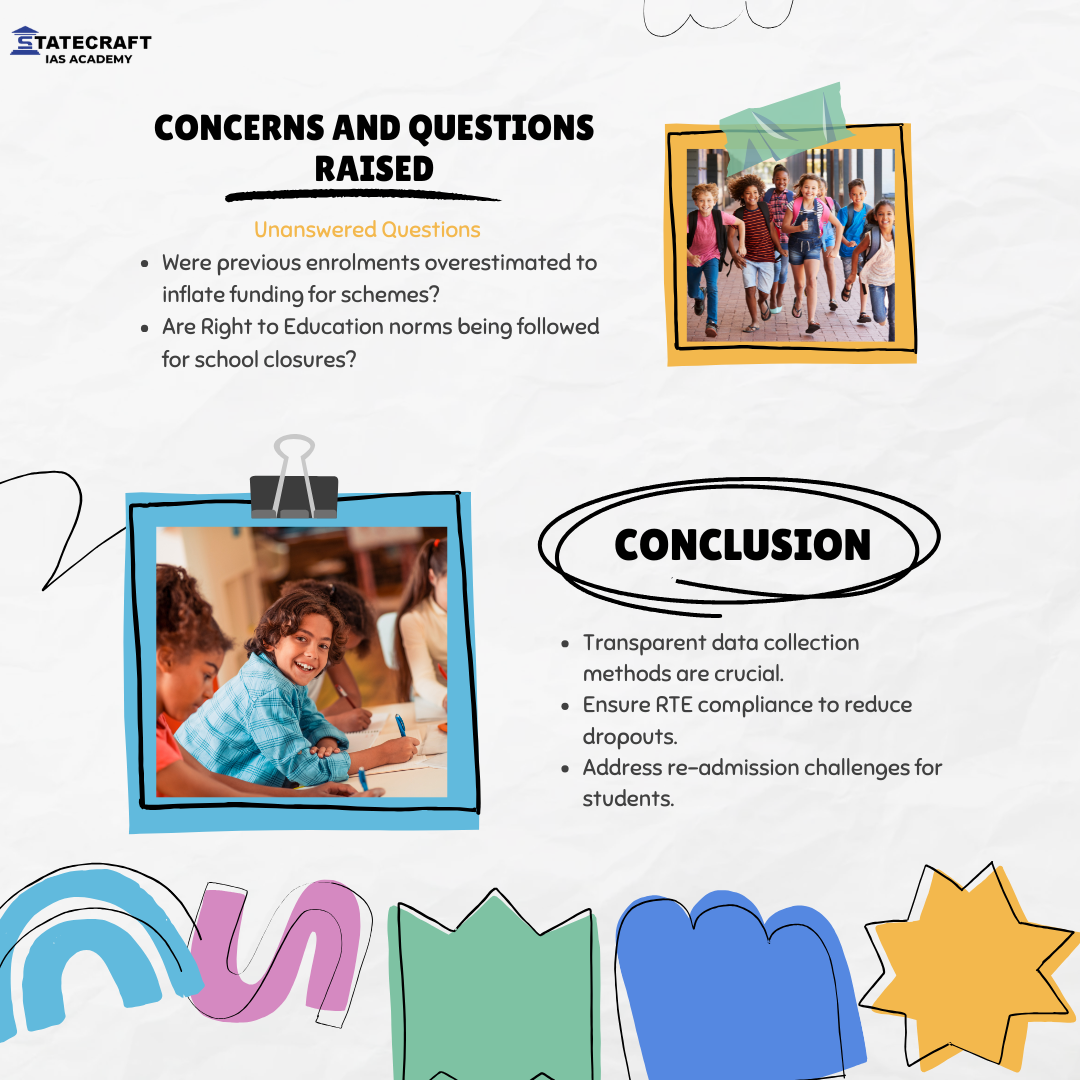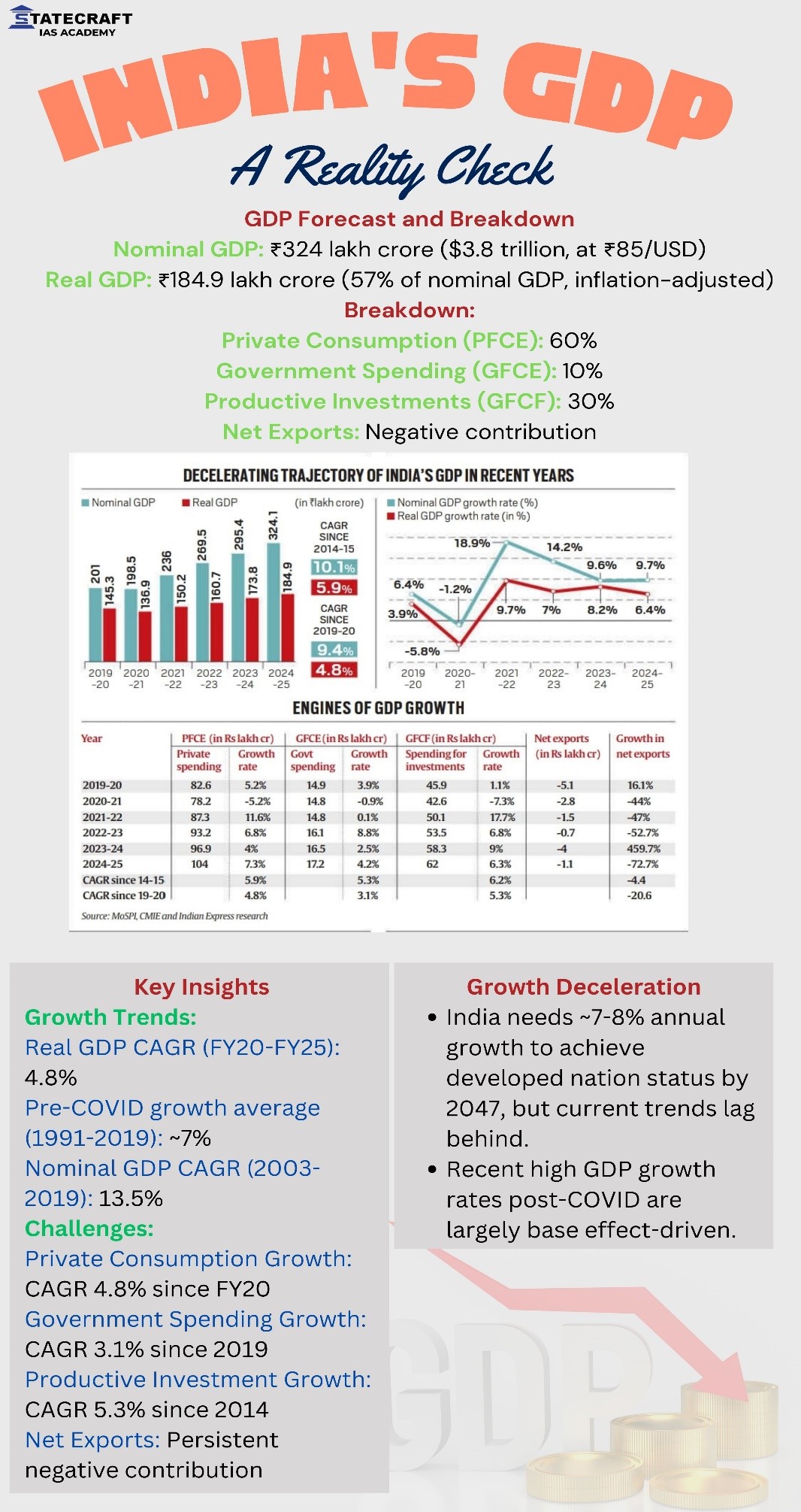Index:
- China’s Earthquake and Its Significance
- 18th Pravasi Bharatiya Divas (PBD) 2025 in Odisha
- Inter-Ministerial Committee for AI Governance in India
- Understanding the Drop in School Enrolments in India Insights from UDISE+ Reports - Infographics
- IED Blasts in Bijapur and the Naxal Insurgency
- GDP Forecast and Breakdown – Analysis Infographic
1. China’s Earthquake and Its Significance
- Key Facts about the Earthquake
- Date & Time: January 7, 6:35 am IST.
- Magnitude: 7.1 on the Richter scale.
- Epicenter: Tingry County, Shigatse region, Tibetan China (10 km depth, 80 km north of Mt. Everest).
- Casualties: As of reports, 95 dead, 130 injured, hundreds of houses flattened in China. Updates awaited from Nepal and other affected areas.
- Tremors Felt: Kathmandu (Nepal), Thimphu (Bhutan), Kolkata (India).
- Location Significance
- Geographical Significance:
- Tingry County: Located in the Shigatse region of Tibet, ~4-5 km above sea level.
- The region is a gateway to Mt. Everest and a popular tourist destination.
- Spiritual Importance: The seat of the Panchen Lama of Tibetan Buddhism.
- Geological Significance:
- The earthquake occurred in the Lhasa terrane, a fragment of the Earth’s crust in the Tibetan Plateau.
- The region is tectonically active due to the ongoing collision of the Indian and Eurasian plates, moving at ~60 mm/year.
- This tension has led to repeated seismic activity; the region has experienced 21 earthquakes of magnitude 6 or higher since 1950.
- Relevance to Development Projects
- Hydroelectric Dam:
- The Lhasa terrane includes the site of the world’s largest hydroelectric-power dam, under construction by China on the Yarlung Tsangpo River.
- Energy Output: Estimated to generate 300 billion kWh/year.
- India’s Concern:
- Yarlung Tsangpo becomes the Brahmaputra River in India.
- Potential impact on the river’s perennial flow affecting Arunachal Pradesh and Assam.
- Earthquake Risk to Infrastructure:
- The region’s seismic activity poses risks to large-scale projects, such as dams, and the communities living downstream.
- Environmental Impacts
- Himalayan Region as the “Third Pole”:
- Holds vast water resources in rivers, glaciers, and lakes that millions depend on.
- Earthquakes can:
- Alter river courses.
- Destabilize glaciers and lakes, increasing flood risks.
- Accelerate climate vulnerabilities in the fragile Himalayan ecosystem.
- Causes of the Earthquake
- Tectonic Movements:
- The collision of the Indian Plate with the Eurasian Plate (ongoing for 50 million years) created the Himalayan mountains.
- Seismic activity occurs as the plates adjust to the tension caused by their movement.
- The Indian Plate pushes into the Eurasian Plate at ~60 mm/year.
- Seismic History of Lhasa Terrane:
- Historical Data: Over 21 earthquakes of magnitude 6+ recorded since 1950.
- Largest Quake: Magnitude 6.9 near Mainling in 2017, located 960 km east of Tingry County.
2. 18th Pravasi Bharatiya Divas (PBD) 2025 in Odisha
- Key Facts
- Event: 18th Pravasi Bharatiya Divas (PBD).
- Dates: January 8-10, 2025.
- Location: Bhubaneswar, Odisha.
- Theme: “Diaspora’s contribution to a Viksit Bharat” (Developed India).
- Delegates: Over 3,000 delegates from 70 countries.
- Previous Edition: Held in Indore, Madhya Pradesh, in January 2023.
- Chief Guests & Key Dignitaries
- Chief Guest: Christine Carla Kangaloo, President of Trinidad and Tobago (addressing virtually).
- Guest of Honour (Youth PBD): Dr. Dev Pragad, CEO and co-owner of Newsweek.
- Prime Minister Narendra Modi: To inaugurate the event and flag off the Pravasi Bharatiya Express.
- President Droupadi Murmu: To chair the valedictory session and confer awards.
- Ministerial Delegations: From Mauritius, Malaysia, and South Africa.
- Highlights of the Event
- Diaspora Engagement:
- Focus on the Indian diaspora’s role as a “living bridge” between India and their adopted homelands.
- Discussions on partnering with India to achieve the vision of Viksit Bharat by 2047.
- Special Initiatives:
- Pravasi Bharatiya Express:
- A tourist train for the diaspora, flagged off remotely by the PM.
- It will visit multiple tourist and religious destinations over three weeks.
- Mandvi to Muscat Focus:
- Showcasing rare documents and stories of migration from Gujarat’s Mandvi to Oman’s Muscat.
- Pravasi Bharatiya Express:
- Pravasi Bharatiya Samman Awards:
- 27 diaspora members from 24 countries to be honoured for their achievements and contributions.
- Plenary Sessions:
- Chaired by Union Ministers and moderated by eminent Indians from various fields.
- Odisha’s Role & Preparation
- Cultural Heritage Showcase:
- Odisha to highlight its rich cultural heritage and traditions.
- Identification of 21 tourist sites to be promoted to the diaspora.
- Raghurajpur Visit:
- External Affairs Minister S. Jaishankar and his wife visited Raghurajpur artists’ village, showcasing Odisha’s cultural richness.
- Chief Secretary’s Statement: Focus on making the event comfortable and pleasurable for participants.
- Importance of the Event
- Vision of Viksit Bharat by 2047: Strengthening the connection between India and its diaspora for developmental goals.
- Diaspora’s Role:
- Contribution to India’s economic, cultural, and social development.
- Promoting India’s soft power and fostering international relations.
- Global Networking: Opportunity for delegates from 70 nations to interact and collaborate with Indian counterparts.
Tourism Boost: Promotion of Odisha as a global tourist destination.
3. Inter-Ministerial Committee for AI Governance in India
- Context
- The Union Government is focusing on the governance of Artificial Intelligence (AI) to maximize its benefits while mitigating risks.
- The IndiaAI Mission, under the Union Ministry of Electronics and Information Technology (MeitY), released a report on AI guidelines, seeking public feedback.
- Key Recommendations
- Inter-Ministerial AI Coordination Committee:
- Proposed to oversee AI governance in India.
- Ensures collaboration across ministries to address the multidisciplinary impact of AI.
- Technical Secretariat:
- To be housed within the IT Ministry.
- Functions:
- Pooling expertise from various departments and regulators.
- Mapping stakeholders in the AI ecosystem.
- Assessing risks related to AI systems.
- Conducting AI-related research.
- Light Regulatory Framework:
- Focus on maximizing economic and societal gains from AI.
- Use of regulations as “guardrails” to minimize potential harms.
- Principles for AI Governance
The report outlines several key principles to guide the development, deployment, and regulation of AI systems in India:
- Transparency: Ensure meaningful disclosure of AI systems’ development processes and capabilities.
- Accountability: Developers and deployers of AI systems must take responsibility for their applications.
- Safety, Reliability, and Robustness: AI systems should be designed to ensure safety and reliability.
- Privacy and Security: Safeguarding personal data and ensuring robust cybersecurity for AI systems.
- Fairness and Non-Discrimination: Prevent bias in AI systems to ensure equitable outcomes.
- Human-Centric and Ethical Values: AI systems should adhere to the principle of “do no harm” and uphold human dignity.
- Inclusive and Sustainable Innovation: AI innovations should distribute benefits equitably across society.
- Digital by Design Governance: Leverage digital technologies to operationalize these principles.
- Implications for India
- Maximizing AI’s Potential:
- Aligning AI governance with India’s vision for a tech-driven economy.
- Strengthening India’s global position in AI innovation and adoption.
- Risk Mitigation:
- Preventing misuse of AI systems while promoting ethical practices.
- Addressing concerns related to privacy, bias, and safety.
- Strengthening Institutions:
- Creation of a technical secretariat and inter-ministerial committee will foster multidisciplinary collaboration.
- Societal Benefits:
- Equitable distribution of AI’s benefits to bridge socio-economic gaps.
- Human-centric AI applications for sectors like healthcare, education, and agriculture.
- Way Forward
- Stakeholder Engagement:
- Continued public consultations to refine AI governance frameworks.
- Involvement of academia, industry, and civil society in policymaking.
- Capacity Building:
- Training government officials and regulators in AI-related domains.
- Promoting research and development in AI technologies.
- Global Collaboration:
- Aligning India’s AI policies with global standards and practices.
Strengthening partnerships for AI innovation and ethical governance.
5. IED Blasts in Bijapur and the Naxal Insurgency
- Context
- Incident: On January 6, 2025, an IED blast in Bijapur, Chhattisgarh, killed eight security personnel and a civilian driver.
- Perpetrators: The attack is attributed to the Communist Party of India (Maoist), a left-wing extremist organization.
- Key Details
- Nature of the Attack:
- Improvised Explosive Devices (IEDs): Heavy explosives were camouflaged and planted strategically.
- Planned with precision; the last similar attack occurred in Dantewada in April 2023.
- Indicates the CPI(Maoist)’s capacity for coordinated attacks despite weakening influence.
- Casualties in 2024:
- Security Forces: 24 personnel killed.
- Insurgents: 296 killed in anti-Maoist operations.
- Civilians: 80 deaths.
- Current State of the CPI (Maoist)
- Flailing Insurgency:
- The organization struggles to maintain its presence, particularly in its last bastion—the Abujmarh jungles and Bastar region.
- Continued reliance on violence reflects its ideological commitment to armed rebellion.
- Historical Context:
- Originated in the early 2000s after merging various Naxalite groups.
- Central ideology revolves around violent methods for achieving its goals.
- Implications
- Setback for Security Forces:
- The attack marks a significant loss early in 2025.
- It underscores the need for better intelligence and preparedness in Maoist-dominated regions.
- Challenge for Anti-Insurgency Operations:
- Intensified operations may increase civilian casualties, potentially fueling Maoist propaganda about state repression.
- A balanced approach is necessary to avoid alienating local communities.
- Potential for Retaliation: Security forces may ramp up operations, risking collateral damage.
- Way Forward
- Military Strategy:
- Enhance operational efficiency and intelligence gathering to counter Maoist activities.
- Ensure the safety of civilians during anti-Maoist campaigns to maintain public trust.
- Ceasefire and Negotiation:
- Leverage civil society actors to explore avenues for a ceasefire agreement.
- Use negotiations to reintegrate disillusioned cadres into the mainstream.
- Development and Rehabilitation:
- Address the root causes of the insurgency, such as poverty, displacement, and lack of governance in tribal areas.
- Promote development projects and inclusive policies to reduce Maoist influence.
- Countering Propaganda:
- Strengthen communication to counter Maoist narratives of state repression.
Build trust with local communities through outreach programs.





